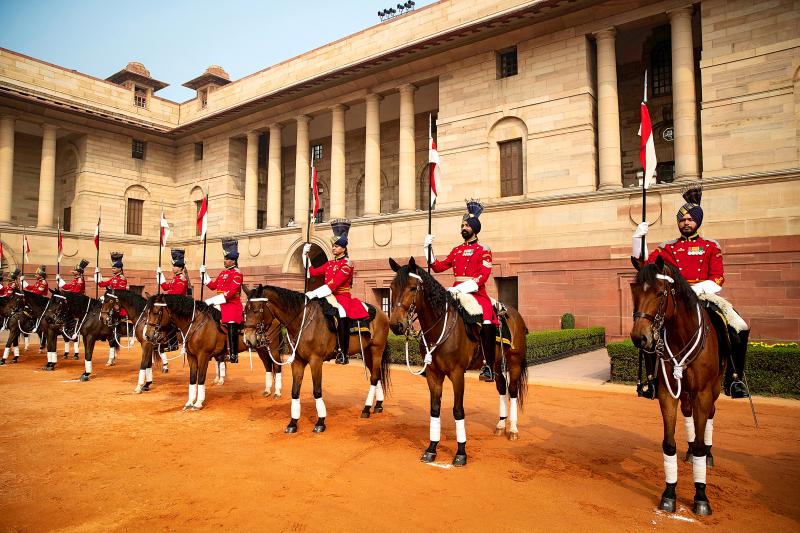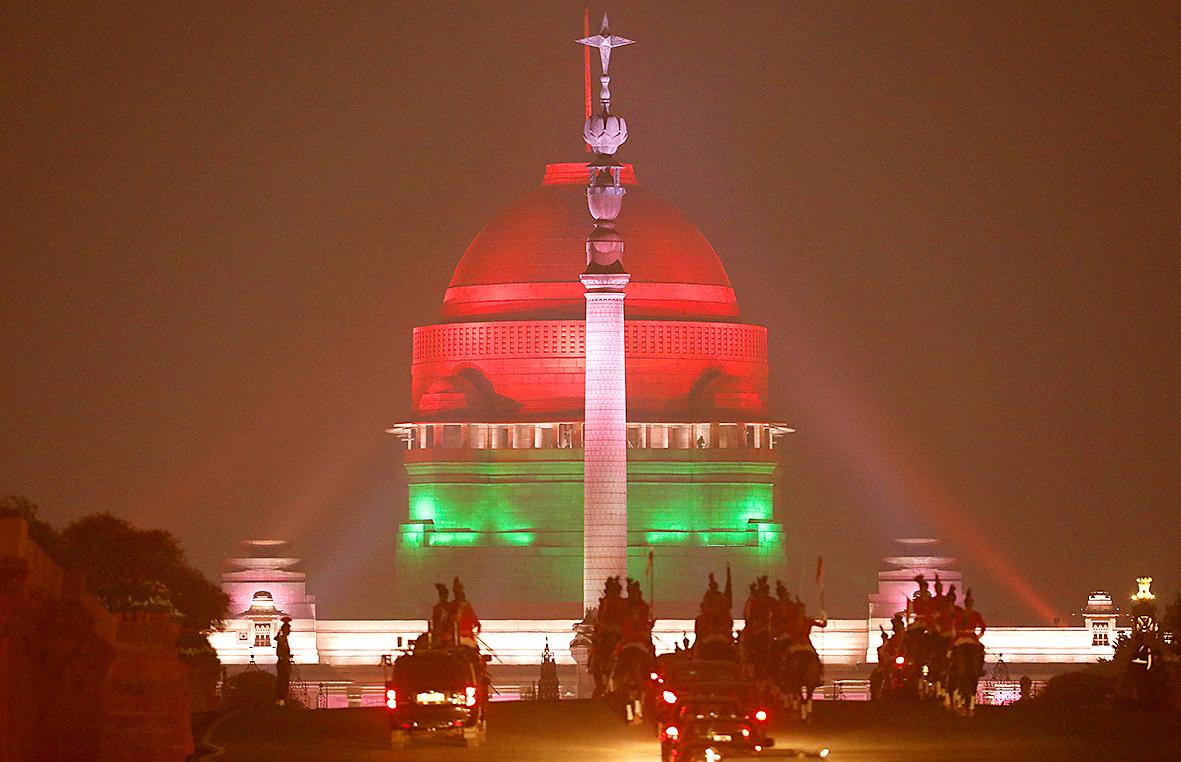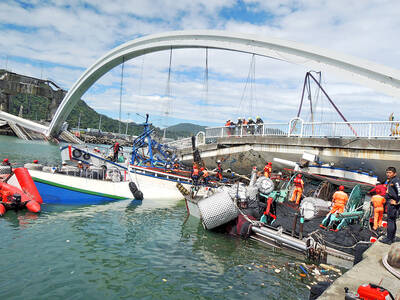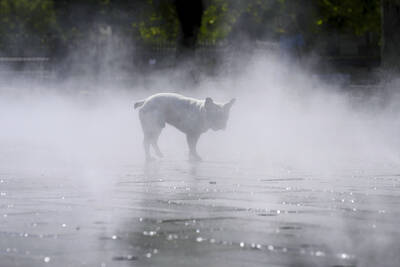A two-mile stretch in Delhi featuring some of India’s most iconic landmarks is to be redeveloped, angering historians and conservationists who say the move will rob the country of its heritage and valuable public space.
Federal authorities last month said they would change the land use for the 86-acre area that includes Parliament House, Rashtrapati Bhavan (the presidential palace) and the India Gate war memorial to “government use” from recreation and public facilities.
Conservationists fear that the Central Vista redevelopment project will obliterate the history and character of the area, which also has among the biggest public spaces in a city of more than 20 million.

Photo: Reuters
“The Central Vista is significant for historical, lived and architectural heritage. Equally importantly, it is a public-use area for tourists and residents, and a green area,” said Kanchi Kohli, a senior researcher at the Center for Policy Research.
“The redevelopment represents a form of ‘government sprawl’ where powerful offices appropriate urban space with little concern for planning or socio-ecological consequences,” she said in e-mailed comments.
In India, as in many countries, rapid urbanization is putting greater pressure on governments to build office blocks and rail networks, which has led to the razing of old buildings and traditional markets.

Photo: Reuters
Cities risk losing not just their history and heritage, but also traditional knowledge which is key to promoting inclusiveness, sustainability and resilience, according to urban experts.
The Central Vista project, estimated to cost 200 billion rupees ($2.6 billion) and due to be completed by 2024, envisages modern buildings replacing century-old structures that are as familiar to many Indians as the Taj Mahal.
The Central Public Works Department, which is overseeing the project, said in its redevelopment proposal that the area currently suffers from inadequate space and infrastructure.
The area lacks basic facilities, amenities and parking, which “leads to congestion and gives a poor public perception”, the proposal said.
“Therefore, there is a need for upgradation.”
SITE FOR CELEBRATIONS
Delhi was established as the capital of the Indian empire in 1911, when the colonial British rulers moved the capital from the eastern city of Calcutta, now called Kolkata.
Architects Edwin Lutyens and Herbert Baker planned the central administrative area of the city, retaining a third of the area for open spaces, including wide lawns that draw crowds of residents, tourists and vendors all year round.
The Rajpath (King’s Way) boulevard connects the iconic India Gate to Rashtrapati Bhavan and is the site of the annual Republic Day celebrations featuring grand displays by the armed forces and a parade of colorful floats from each state.
The Central Vista is an amalgam of traditions from across India: the distinct circular design of Parliament House; the red and beige sandstone from Mughal architecture; and the dome of the Rashtrapati Bhavan inspired by a Buddhist stone monument.
“The historical significance of the Central Vista lies in its architecture, town planning and politics,” said Swapna Liddle, a historian at the Indian National Trust for Art and Cultural Heritage. “Its history is the history of India.”
That does not mean that “it should be frozen in time,” she added, pointing out that several buildings have been upgraded to add amenities such as air-conditioning and internet cable.
“More can be done, as long as our starting point is a will to conserve and prolong the life and use of the existing buildings,” Liddle said.
“Losing heritage to modernization is not inevitable, but it requires careful choices. The decision on what should go and what should stay, and what should come in place of things that are removed” must involve a body of experts, she said.
HERITAGE VS MODERNITY
The question of preserving heritage or modernizing is being debated not just in Delhi, but in cities around the world.
Almost 70 percent of the world’s population will be living in urban areas by 2050, according to estimates by the UN, and governments everywhere are struggling to find space to accommodate booming numbers of city dwellers.
“Land is a scarce resource, but heritage is even more valuable since it cannot be reclaimed or rebuilt,” said Anuj Srivastava, an architect who has filed a petition against the Central Vista project that is pending in the nation’s top court.
Few details of the Central Vista project have been made public, and while several buildings are protected by heritage laws, these guidelines have often been diluted or ignored in the past, he said.
A spokesman for the Central Public Works Department did not respond to requests for comment.
The project needs a detailed study, including assessments of its impact on heritage, the environment and traffic, as well as the possible consequences of accommodating about 70,000 government workers in a small area, Srivastava said.
“Heritage precincts the world over use the principles of adaptive re-use for changing requirements,” he said, referring to the practice of repurposing buildings for new uses while retaining their historic features.
“The Central Vista should follow these principles, and in no circumstance should open spaces meant for public use be appropriated for government buildings and residences,” he said.
The timing of the land-use change notification — in the midst of the deadly coronavirus outbreak that has infected at least 1,200 and killed more than 30 in India — has also angered opposition lawmakers.
Last week, Shashi Tharoor, a member of the opposition Congress party, said in a tweet that the money earmarked for the project must instead be used to deal with the pandemic, which has devastated the country’s poor communities.
“Grand spending on buildings at this time of crisis is a postponable luxury,” he said.

Has the Taiwan People’s Party (TPP) changed under the leadership of Huang Kuo-chang (黃國昌)? In tone and messaging, it obviously has, but this is largely driven by events over the past year. How much is surface noise, and how much is substance? How differently party founder Ko Wen-je (柯文哲) would have handled these events is impossible to determine because the biggest event was Ko’s own arrest on multiple corruption charges and being jailed incommunicado. To understand the similarities and differences that may be evolving in the Huang era, we must first understand Ko’s TPP. ELECTORAL STRATEGY The party’s strategy under Ko was

Before the recall election drowned out other news, CNN last month became the latest in a long line of media organs to report on abuses of migrant workers in Taiwan’s fishing fleet. After a brief flare of interest, the news media moved on. The migrant worker issues, however, did not. CNN’s stinging title, “Taiwan is held up as a bastion of liberal values. But migrant workers report abuse, injury and death in its fishing industry,” was widely quoted, including by the Fisheries Agency in its response. It obviously hurt. The Fisheries Agency was not slow to convey a classic government

It’s Aug. 8, Father’s Day in Taiwan. I asked a Chinese chatbot a simple question: “How is Father’s Day celebrated in Taiwan and China?” The answer was as ideological as it was unexpected. The AI said Taiwan is “a region” (地區) and “a province of China” (中國的省份). It then adopted the collective pronoun “we” to praise the holiday in the voice of the “Chinese government,” saying Father’s Day aligns with “core socialist values” of the “Chinese nation.” The chatbot was DeepSeek, the fastest growing app ever to reach 100 million users (in seven days!) and one of the world’s most advanced and

It turns out many Americans aren’t great at identifying which personal decisions contribute most to climate change. A study recently published by the National Academy of Sciences found that when asked to rank actions, such as swapping a car that uses gasoline for an electric one, carpooling or reducing food waste, participants weren’t very accurate when assessing how much those actions contributed to climate change, which is caused mostly by the release of greenhouse gases that happen when fuels like gasoline, oil and coal are burned. “People over-assign impact to actually pretty low-impact actions such as recycling, and underestimate the actual carbon